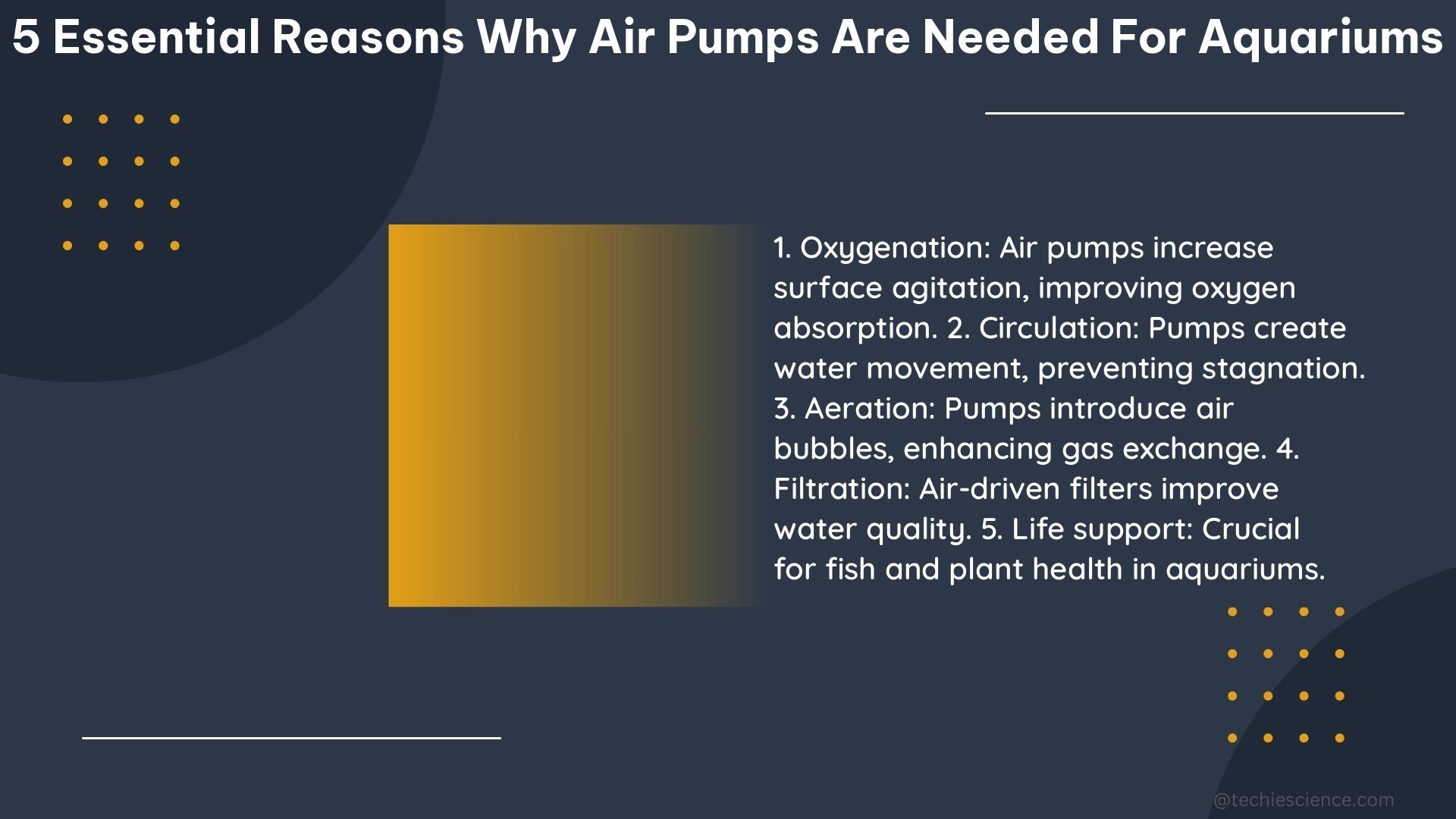Maintaining optimal dissolved oxygen levels, ensuring efficient water circulation, powering filtration systems, enhancing aquarium decor, and providing emergency oxygenation are the five essential reasons why air pumps are indispensable for aquarium enthusiasts. This comprehensive guide delves into the technical details and practical applications of air pumps, equipping you with the knowledge to create a thriving underwater ecosystem.
Dissolved Oxygen Levels: The Lifeblood of Aquatic Ecosystems
Dissolved oxygen (DO) is a critical parameter for the health and well-being of aquatic life. Ideally, the DO levels in an aquarium should be maintained between 5 and 7 parts per million (ppm). Levels below 2 ppm can be detrimental to fish, leading to stress, reduced growth, and even mortality.
Air pumps play a vital role in maintaining optimal DO levels by introducing more oxygen into the water through surface agitation. This process allows carbon dioxide to exit the water while simultaneously facilitating the absorption of oxygen. The increased surface area created by the air bubbles enhances the gas exchange, ensuring a well-oxygenated environment for your aquatic inhabitants.
To determine the appropriate air pump size for your aquarium, consider the following formula:
Air Pump Output (GPH) = Aquarium Volume (gallons) x 1.5
For example, a 50-gallon aquarium would require an air pump with an output of at least 75 gallons per hour (GPH) to maintain adequate DO levels.
Water Circulation: Preventing Stagnation and Promoting Nutrient Distribution

Effective water circulation is essential for the overall health and well-being of your aquarium. Air pumps contribute to this by creating water movement, which helps prevent the formation of dead spots and ensures that all areas of the tank receive adequate oxygen and nutrient distribution.
In larger aquariums, where water circulation can be more challenging, air pumps become even more crucial. By introducing a steady flow of air bubbles, they create a gentle, yet consistent, water movement that promotes the even distribution of essential resources throughout the tank.
To optimize water circulation, consider the following guidelines:
| Aquarium Size | Recommended Air Pump Output (GPH) |
|---|---|
| Up to 20 gallons | 100 GPH |
| 20 to 50 gallons | 200 GPH |
| 50 to 100 gallons | 400 GPH |
| 100 to 200 gallons | 800 GPH |
Remember, these are general recommendations, and the actual air pump size may need to be adjusted based on the specific layout and requirements of your aquarium.
Filtration: Powering Essential Aquarium Equipment
Air pumps play a vital role in powering various filtration equipment, such as protein skimmers and bubble filters, which are essential for maintaining water quality and removing waste and toxins from the aquarium.
Protein skimmers use air bubbles to create a foam that traps organic matter, including proteins, lipids, and other waste products. By removing these contaminants before they can decompose and release harmful ammonia and nitrites, protein skimmers significantly improve water quality and create a healthier environment for your fish.
Bubble filters, on the other hand, use the air bubbles generated by the pump to create a gentle, yet effective, water flow that draws in debris and waste. This filtration method is particularly useful for aquariums with delicate or sensitive fish, as it avoids the strong suction associated with traditional mechanical filters.
When selecting an air pump to power your filtration equipment, consider the specific requirements of the devices you plan to use. Ensure that the air pump’s output (GPH) is compatible with the recommended specifications of your filtration system for optimal performance.
Decorative Enhancements: Bringing Aquariums to Life
Air pumps can also be used to operate decorative items within your aquarium, such as bubblers and waterfalls. These features not only add visual interest and aesthetic appeal to your underwater landscape but also contribute to the overall well-being of your aquatic inhabitants.
Bubblers, for example, create a mesmerizing display of rising air bubbles that can captivate both fish and aquarium viewers. These decorative elements not only enhance the visual appeal of your aquarium but also contribute to the overall water movement and oxygenation.
Waterfalls, on the other hand, introduce a gentle, soothing flow of water that can mimic natural environments. The cascading water not only adds visual interest but also helps to aerate the water, improving dissolved oxygen levels.
When selecting an air pump to power your decorative features, consider the size and power requirements of the specific items you plan to use. Ensure that the air pump’s output is sufficient to operate the decorations without overwhelming the aquarium’s ecosystem.
Emergency Oxygenation: Safeguarding Your Aquatic Inhabitants
In the event of a power outage or other emergency situations, an air pump can provide a manual method for adding oxygen to the water. By scooping out some aquarium water, filling a clean container, and pouring it back into the tank, you can help maintain oxygen levels and support your fish during challenging situations.
This emergency oxygenation technique can be a lifesaver, especially for aquariums with sensitive or delicate fish species that require high dissolved oxygen levels. It’s essential to have a backup air pump or a battery-powered model on hand to ensure that you can quickly and effectively respond to any disruptions in your aquarium’s power supply.
Remember, the size and output of the air pump you choose for emergency oxygenation should be appropriate for the volume of your aquarium. Refer to the earlier guidelines to determine the recommended air pump size based on your tank’s capacity.
By understanding the five essential reasons why air pumps are needed for aquariums, you can create a thriving, well-oxygenated, and visually captivating underwater ecosystem that supports the health and well-being of your aquatic inhabitants.
References:
– Aquarium Air Pump Sizing Guide
– The Importance of Aquarium Air Pumps
– How Air Pumps Work in Aquariums
– Aquarium Air Pump Troubleshooting
– DIY Aquarium Air Pump System
